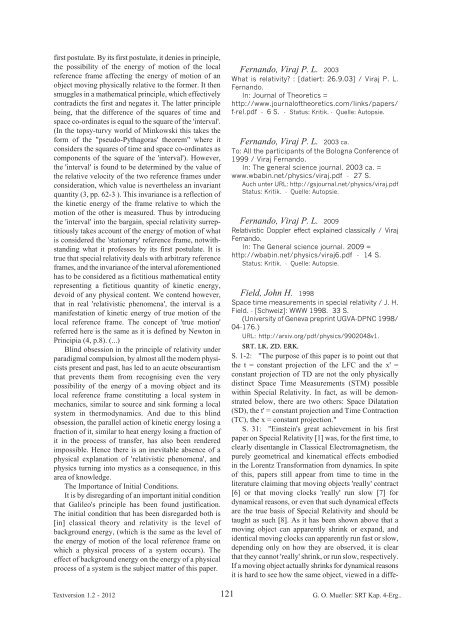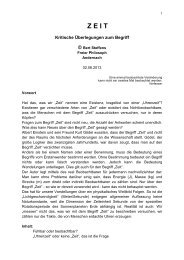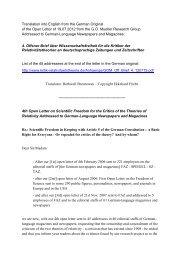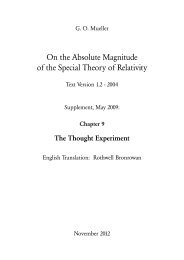2394 weitere kritische Veröffentlichungen - Kritische Stimmen zur ...
2394 weitere kritische Veröffentlichungen - Kritische Stimmen zur ...
2394 weitere kritische Veröffentlichungen - Kritische Stimmen zur ...
Erfolgreiche ePaper selbst erstellen
Machen Sie aus Ihren PDF Publikationen ein blätterbares Flipbook mit unserer einzigartigen Google optimierten e-Paper Software.
first postulate. By its first postulate, it denies in principle,<br />
the possibility of the energy of motion of the local<br />
reference frame affecting the energy of motion of an<br />
object moving physically relative to the former. It then<br />
smuggles in a mathematical principle, which effectively<br />
contradicts the first and negates it. The latter principle<br />
being, that the difference of the squares of time and<br />
space co-ordinates is equal to the square of the 'interval'.<br />
(In the topsy-turvy world of Minkowski this takes the<br />
form of the "pseudo-Pythagoras' theorem" where it<br />
considers the squares of time and space co-ordinates as<br />
components of the square of the 'interval'). However,<br />
the 'interval' is found to be determined by the value of<br />
the relative velocity of the two reference frames under<br />
consideration, which value is nevertheless an invariant<br />
quantity (3, pp. 62-3 ). This invariance is a reflection of<br />
the kinetic energy of the frame relative to which the<br />
motion of the other is measured. Thus by introducing<br />
the 'interval' into the bargain, special relativity surreptitiously<br />
takes account of the energy of motion of what<br />
is considered the 'stationary' reference frame, notwithstanding<br />
what it professes by its first postulate. It is<br />
true that special relativity deals with arbitrary reference<br />
frames, and the invariance of the interval aforementioned<br />
has to be considered as a fictitious mathematical entity<br />
representing a fictitious quantity of kinetic energy,<br />
devoid of any physical content. We contend however,<br />
that in real 'relativistic phenomena', the interval is a<br />
manifestation of kinetic energy of true motion of the<br />
local reference frame. The concept of 'true motion'<br />
referred here is the same as it is defined by Newton in<br />
Principia (4, p.8). (...)<br />
Blind obsession in the principle of relativity under<br />
paradigmal compulsion, by almost all the modern physicists<br />
present and past, has led to an acute obscurantism<br />
that prevents them from recognising even the very<br />
possibility of the energy of a moving object and its<br />
local reference frame constituting a local system in<br />
mechanics, similar to source and sink forming a local<br />
system in thermodynamics. And due to this blind<br />
obsession, the parallel action of kinetic energy losing a<br />
fraction of it, similar to heat energy losing a fraction of<br />
it in the process of transfer, has also been rendered<br />
impossible. Hence there is an inevitable absence of a<br />
physical explanation of 'relativistic phenomena', and<br />
physics turning into mystics as a consequence, in this<br />
area of knowledge.<br />
The Importance of Initial Conditions.<br />
It is by disregarding of an important initial condition<br />
that Galileo's principle has been found justification.<br />
The initial condition that has been disregarded both is<br />
[in] classical theory and relativity is the level of<br />
background energy, (which is the same as the level of<br />
the energy of motion of the local reference frame on<br />
which a physical process of a system occurs). The<br />
effect of background energy on the energy of a physical<br />
process of a system is the subject matter of this paper.<br />
Fernando, Viraj P. L. 2003<br />
What is relativity? : [datiert: 26.9.03] / Viraj P. L.<br />
Fernando.<br />
In: Journal of Theoretics =<br />
http://www.journaloftheoretics.com/links/papers/<br />
f-rel.pdf - 6 S. - Status: Kritik. - Quelle: Autopsie.<br />
Fernando, Viraj P. L. 2003 ca.<br />
To: All the participants of the Bologna Conference of<br />
1999 / Viraj Fernando.<br />
In: The general science journal. 2003 ca. =<br />
www.wbabin.net/physics/viraj.pdf - 27 S.<br />
Auch unter URL: http://gsjournal.net/physics/viraj.pdf<br />
Status: Kritik. - Quelle: Autopsie.<br />
Fernando, Viraj P. L. 2009<br />
Relativistic Doppler effect explained classically / Viraj<br />
Fernando.<br />
In: The General science journal. 2009 =<br />
http://wbabin.net/physics/viraj6.pdf - 14 S.<br />
Status: Kritik. - Quelle: Autopsie.<br />
Field, John H. 1998<br />
Space time measurements in special relativity / J. H.<br />
Field. - [Schweiz]: WWW 1998. 33 S.<br />
(University of Geneva preprint UGVA-DPNC 1998/<br />
04-176.)<br />
URL: http://arxiv.org/pdf/physics/9902048v1.<br />
SRT. LK. ZD. ERK.<br />
S. 1-2: "The purpose of this paper is to point out that<br />
the t = constant projection of the LFC and the x' =<br />
constant projection of TD are not the only physically<br />
distinct Space Time Measurements (STM) possible<br />
within Special Relativity. In fact, as will be demonstrated<br />
below, there are two others: Space Dilatation<br />
(SD), the t' = constant projection and Time Contraction<br />
(TC), the x = constant projection."<br />
S. 31: "Einstein's great achievement in his first<br />
paper on Special Relativity [1] was, for the first time, to<br />
clearly disentangle in Classical Electromagnetism, the<br />
purely geometrical and kinematical effects embodied<br />
in the Lorentz Transformation from dynamics. In spite<br />
of this, papers still appear from time to time in the<br />
literature claiming that moving objects 'really' contract<br />
[6] or that moving clocks 'really' run slow [7] for<br />
dynamical reasons, or even that such dynamical effects<br />
are the true basis of Special Relativity and should be<br />
taught as such [8]. As it has been shown above that a<br />
moving object can apparently shrink or expand, and<br />
identical moving clocks can apparently run fast or slow,<br />
depending only on how they are observed, it is clear<br />
that they cannot 'really' shrink, or run slow, respectively.<br />
If a moving object actually shrinks for dynamical reasons<br />
it is hard to see how the same object, viewed in a diffe-<br />
Textversion 1.2 - 2012 121<br />
G. O. Mueller: SRT Kap. 4-Erg..





